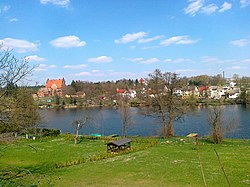Biały Bór
Biały Bór | |
|---|---|
 Lake Ławiczka in Biały Bór | |
| Coordinates: 53°53′55″N 16°50′16″E / 53.89861°N 16.83778°E | |
| Country | |
| Voivodeship | West Pomeranian |
| County | Szczecinek |
| Gmina | Biały Bór |
| Established | 13th century |
| Town rights | 1382 |
| Government | |
| • Mayor | Paweł Stanisław Mikołajewski |
| Area | |
• Total | 12.82 km2 (4.95 sq mi) |
| Population | |
• Total | 2,226 |
| • Density | 174/km2 (450/sq mi) |
| Time zone | UTC+1 (CET) |
| • Summer (DST) | UTC+2 (CEST) |
| Postal code | 78-425 |
| Area code | +48 94 |
| Car plates | ZSZ |
| National roads | |
| Website | http://bialybor.com.pl/ |
Biały Bór (Polish: [ˈbjawɨ ˈbur] ⓘ; German: Baldenburg) is a town in Szczecinek County, West Pomeranian Voivodeship, Poland, with 2,226 inhabitants as of December 2021.[3]
History
[edit]
The settlement was founded in the 13th century by a local noble Sebastian Lubjanski.[5] It was part of Poland, until the Teutonic invasion in the early 14th century. Located at a formerly important crossroad, the Teutonic Knights built a fortification here, and in 1382[5] the settlement received Kulm law town rights. The town's development was stopped by a large fire in 1408.[6] No traces remain of the castle, but remnants of the medieval city wall have been incorporated in some later houses.
During the Thirteen Years' War it was recaptured by the Poles in 1461, and it was confirmed as part of Poland in 1466. Since then it was administratively located in the Człuchów County in the Pomeranian Voivodeship[7] until the First Partition of Poland in 1772, when it was annexed by Prussia,[6] and subsequently from 1871 it was part of Germany.
Up until the 20th century, the town economy consisted mostly of fishing, agriculture, crafts and local trade. It was the centre of a cloth manufacturing industry from the 16th century until the 19th century, when it had to close due to competition from more modern industries. A railway connection to the town was established in 1878. While most of Gdańsk Pomerania was reintegrated with Poland after the country regained independence in 1918, the town was one of the few which remained within Germany and was included in the newly established province, provocatively named towards Poles the Frontier March of Posen-West Prussia.[6] In 1939, the town had 2,292 inhabitants.[8] The town had a Jewish community and a small synagogue prior to World War II and the Holocaust.[9] During the war, in January 1945, a German-perpetrated death march of Allied prisoners-of-war from the Stalag XX-B POW camp passed through the town.[10] The town was integrated with Poland in 1945.[6]
From 1950 to 1998, the town belonged to the Koszalin Voivodeship. A horse stud farm was founded in Biały Bór in 1956.[11] Battle scenes for the 1969 film Colonel Wolodyjowski were filmed in Biały Bór.
Transport
[edit]There is a railway station in Biały Bór.
Notable residents
[edit]- Georg Ludwig Rudolf Maercker (1865-1924), World War I general
- Karl Ruß (1833-1899), ornithologist[12]
References
[edit]- ^ "Władze miasta". bialybor.com.pl (in Polish). Miasto i Gmina Biały Bór. Retrieved 2022-09-07.
- ^ "Local Data Bank". Statistics Poland. Retrieved 2022-09-07. Category K1, group G441, subgroup P1410. Data for territorial unit 3215034.
- ^ a b "Local Data Bank". Statistics Poland. Retrieved 2022-09-07. Category K3, group G7, subgroup P1336. Data for territorial unit 3215034.
- ^ "Local Data Bank". Statistics Poland. Retrieved 2022-09-07. Category K3, group G7, subgroup P2425. Data for territorial unit 3215034.
- ^ a b "Biały Bór (zachodniopomorskie)". Polska w liczbach (in Polish). Retrieved 23 October 2019.
- ^ a b c d "Historia". Miasto i Gmina Biały Bór (in Polish). Retrieved 23 October 2019.
- ^ Biskup, Marian; Tomczak, Andrzej (1955). Mapy województwa pomorskiego w drugiej połowie XVI w. (in Polish). Toruń. p. 88.
{{cite book}}: CS1 maint: location missing publisher (link) - ^ Weise, Erich, ed. (1981) [1966]. Handbuch der historischen Stätten. Ost- und Westpreussen (in German). Stuttgart: Kröner. pp. 7–8. ISBN 3-520-31701-X.
- ^ "Biały Bór - Virtual Shtetl". www.sztetl.org.pl. Archived from the original on 2015-05-09.
- ^ Kaszuba, Sylwia. "Marsz 1945". In Grudziecka, Beata (ed.). Stalag XX B: historia nieopowiedziana (in Polish). Malbork: Muzeum Miasta Malborka. pp. 102, 109. ISBN 978-83-950992-2-9.
- ^ "Tradycje jeździeckie w Białym Borze". Biały Bór (in Polish). Retrieved 22 October 2023.
- ^ Popular Science Monthly Volume 39 September 1891, Take Care of the Birds! by Karl Russ retrieved 26 October 2018
External links
[edit]- Official website (in Polish)
- Jewish Community of Biały Bór on Virtual Shtetl



